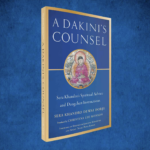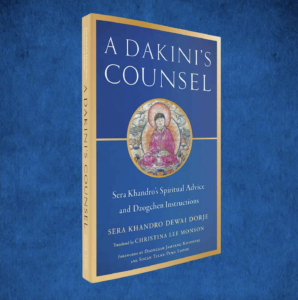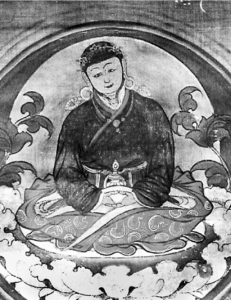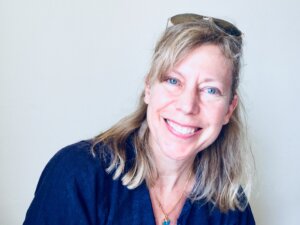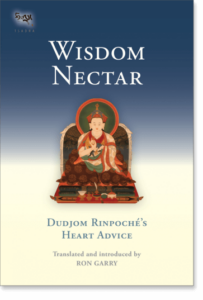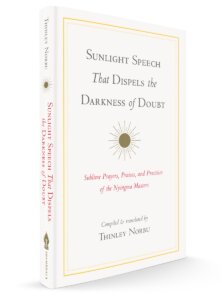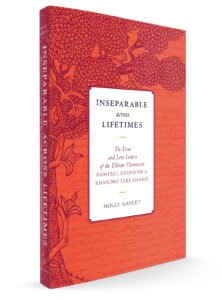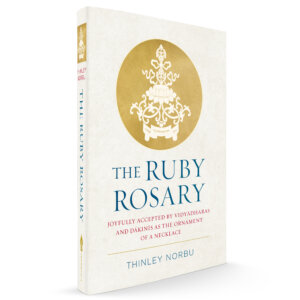Sometimes The Only Thing to Do is Pray
A Selection from Chapter 1
Excerpted from A Dakini's Counsel: Sera Khandro's Spiritual Advice and Dzogchen Instructions
By Sera Khandro
Translated by Christina Monson
About This Title
Sera Khandro Dewai Dorje was a modern Tibetan Buddhist teacher who single-pointedly pursued a life of Dharma while balancing family life and public teaching. This collection of her advice, prayers, dreams, prophecies, and treasures (terma) is both biographical and instructional. It comes from within the tradition of Dzogchen, replete with practices for resting in the nature of mind. This lineage forms the bedrock of Christina Monson’s own spiritual path, lending a deep intimacy to the translations, which serve as a window into Sera Khandro’s life, teachings, and rich inner experience.
Prayer
Chapter 1, page 1-6
Sometimes the only thing to do is pray.
In the Buddhist tradition in general, to pray is to surrender to the infinite manifestative potency of interdependence: causes and conditions coming together such that anything and indeed everything is possible. In the Great Perfection tradition, prayer often carries a deeply devotional flavor, reflecting the special relationship between teacher and disciple at the core of its authentic transmission. Dewai Dorje’s unbounded devotion, love, and joy frequently burst forth through prayers. These sublime portals into her inner world reveal ways she worked with some of the most powerful emotions of her life and experienced their fullest transformative potential. Similarly, she grounded herself in times of bottomless pain, grief, and sorrow through expressions of heartfelt longing and aspiration. Her intimacy with the vast spectrum of human feeling shines through the numerous prayers she composed throughout her biographical writing and treasure revelations.
Chapter 1 welcomes us through prayer into Dewai Dorje’s sea of deep love as seen for and through the eyes and heart of her lama and consort, Drime Ozer. We are treated to a glimpse of their relationship through this first piece, “An Offering from the Vulture to the Cuckoo,” a poetic letter authored by Drime Ozer himself. While all other selected translations here were penned by Dewai Dorje, this unique prayer is a rare piece of his original writing. Little of the bulk of Drime Ozer’s treasure collection, unlike that of his father Dudjom Lingpa, appears to have survived the turmoil of post 1959 Tibet. However, some selections of his writing, ritual practice compositions, and profound instructions are included in Dewai Dorje’s Collected Works. A notable exception is his longest known existent work, an as-yet untranslated commentary on the meaning of his father’s seminal teaching Buddhahood without Meditation.
Drime Ozer’s letter to Dewai Dorje takes us into their multidimensional connection as he lauds her special qualities and prays for her longevity. Half prayer, half poem, the language overflows with reverence and love for her. The second half tells the tale of a white vulture and a cuckoo to intimate the connection between Drime Ozer and Dewai Dorje with metaphoric imagery. This unique love language, drawing from the natural world, is found elsewhere in Dewai Dorje’s writings. In the poem that directly follows this prayer, seemingly as a response to it, she tells the tale of a “blue lady cuckoo” who perfects Secret Mantra practice and concludes,
These secret words about secret conduct,
inspired by the white vulture [Drime Ozer],
naturally occurred from whatever arose.
She also refers to Drime Ozer as a “white vulture” in his biography.2 There she recounts a dream where Drime Ozer meets his father Dudjom Lingpa, who instructs him to unite with the magical emanation of Vajravarahi, Dakini Sukha Vajra (Dewai Dorje), to overcome negative circumstances in his life. Dudjom Linga predicts,
Hey, hey!
When the luminescence of the eastern sky
is welcomed by the roar of the southern turquoise dragon [Dewai Dorje]
and the triple-skilled white [vulture] soars in space,
if splendor and thunder come together,
they are sure to make harmony as one.
The words of the cryptic prophecy continue but clearly refer to him and Dewai Dorje. As further evidence of their prophesized connection beyond the confines of time and space, Drime Ozer makes mention of her connection to his past lives. Some of these specific incarnations are also identified by Dewai Dorje in Drime Ozer’s biography where she lists, “At Yarlha Shampo, he was born as Pema Ledrel Tsal. At Dragdra Drogmoche, he was Longchen Dorje Ziji. At Tarpaling in Bumthang, Bhutan, he came as Pema Lingpa. At Yarlung, he was born as Urgyen Samten Lingpa.”
Such long-term connection stretching across lifetimes defies ordinary notions of relationship. It is a repeated theme between Dewai Dorje and Drime Ozer. The topic of Drime Ozer’s past incarnations comes up again in “The Ennobling Deeds of All Buddhas and Their Heirs.” There, his past lives as important treasure revealers are emphasized. The Nyingma tradition holds as a core tenet that the activities of realized beings include the revelation of treasures. Myriad in form and modality, treasures are encrypted wisdom teachings. The tradition identifies one hundred masters who are considered great treasure revealers, including five considered to be especially significant.3 Dewai Dorje’s list of Drime Ozer’s past lives name at least four with the treasure revealer name Lingpa: Pema Lingpa, Urgyen Samten Lingpa, Dodrul Lingpa, and Rok Dechen Lingpa.
Notable as well in the first prayer is the way Drime Ozer refers to Dewai Dorje using different names. He begins the homage by introducing the three kayas, dimensions of wisdom form. These are the dharmakaya, which is connected to mind’s empty essence, the sambhogakaya, which is connected to mind’s lucid and blissful nature, and the nirmanakaya, which is connected to mind’s compassionate capacity.4 Dakinis, wisdom manifesting through the feminine principle, are present in each dimension. In paying homage to Vajravarahi (Dorje Phagmo), Dewai Dorje’s principal tutelary deity, he is revering Dewai Dorje herself as a manifestation of mind’s empty and blissful unity. Her special connection with this deity is also further reflected in references to Khacho, the buddha field connected with Vajravarahi.
Dewai Dorje was a practitioner who had mastered the yogic teachings found in the inner tantric approach of anuyoga. These are powerful techniques for directly actualizing the potential of the body’s subtle network of energy channels, winds, and vital essences to enable realization of primordial wisdom. Relying upon both one’s own and another’s body, the anuyoga practitioner induces experiences of bliss to swiftly catalyze and deepen recognition of mind’s nature. As restrictions to the movement of wisdom winds through the body are lifted, the practitioner’s capacity to encounter the entirety of perceptual experience as teacher and teaching and as phenomena of purity is enhanced. In this context, “wind-mind” is a designation used to refer to the mobile aspect of consciousness, refined and rendered pliable through these practices.
Indeed, Drime Ozer himself was a master who had fully perfected the techniques of anuyoga as well. As such, he was a fully qualified consort for Dewai Dorje, her “heruka of great bliss,” as she too was for him. Heruka is a Sanskrit term indicating a wrathful, “blood-drinking” deity. As a tantric couple, Drime Ozer and Dewai Dorje practiced divine union as a yab yum (masculine and feminine) couple, using visualization of the wrathful deities Hayagriva and Vajravarahi and other techniques. Their special relationship thus involved being destined tantric partners for each other, as well as having a mutually reciprocal guru-disciple bond. Dewai Dorje’s love and devotion for Drime Ozer as her lama, consort, and treasure-revealing partner are paramount themes throughout her writing.
She celebrates his realization in “The Accomplished Secret Mantra Yogi.” Likening him to the primordial Buddha Samantabhadra and the Second Buddha Padmasambhava, the great Indian adept who helped the Tibetan king Trisong Deutsen overcome obstacles to the propagation of the Buddhadharma in Tibet in the eighth century, she lauds his exalted level of realization. To see “the truth of ultimate reality,” as he did, is to directly encounter the empty yet luminous nature of mind precisely as it is, within the context of the Great Perfection. This approach—which emphasizes such an encounter and the subsequent training of familiarity with it until stability is achieved—is the only way to untangle the web of dualistic thinking and its mistaken understanding of reality. It’s the only place where freedom from the confines of conceptual mind is found. This is what enabled Drime Ozer to “dance” with “wisdom’s illusions”: to be in the world of relative appearances but not be enslaved by them. This, of course, is made possible through realizing nothing that appears truly exists. Rather, according to Dzogchen, phenomenal existence is none other than a manifestation of the ground from which it arises: luminous, empty awareness. For Dewai Dorje, Drime Ozer’s realization of this fundamental truth made him a buddha, transcending even the limitation of necessarily appearing in a body made of flesh and blood.
“Prayer of a Crazy, Carefree Lady” uncovers more subtle qualities of his meditative presence, while “The Ennobling Deeds of All Buddhas and Their Heirs” unfolds Dewai Dorje’s utter disbelief and joy at having him in her life, as well as her despair at not being with him. This prayer is dated to the Tibetan year of the Dog. This may refer to 1911, according to the Western calendar, a time of intense turmoil for Dewai Dorje as she struggled to find her way without family or support as an outsider in the communities of eastern Tibet, where she had newly arrived.
The remaining prayers in the chapter unfold other dimensions of Dewai Dorje’s life in early nineteenth-century Golok. “I Supplicate Pema Totreng Tsal” laments the hypocrisies of fake treasure revealers. Dewai Dorje lived within a world of Dharma communities shaped by beliefs about the continuity of spiritual teachings from Guru Padmasambhava and his Tibetan consort Yeshe Tsogyal in eighth-century Tibet up to her own time and place in early twentieth-century eastern Tibet. These treasures were hidden in the physical world as well as in the intangible domain of the minds of those who were destined to discover them, the treasure revealers. The various mechanisms of their revelation and dissemination made sacred the landscape of Dewai Dorje’s life.
Even so, against such a highly sacrosanct backdrop, deceit existed. The degeneration of pure Dharma teachings and traditions for its followers is one sign of what made that time “dark” for Dewai Dorje. While Buddhist cosmology stemming from Indian sources labels the current age one of dissolution when all things decline, Dewai Dorje identifies in this prayer specific negative characteristics of treasure revealers proximate to her in time and space. To ensure she remains free from such bad behavior, she concludes with an aspiration for the circumstances of her authentic Great Perfection practice to prevail.
Remaining selections include a refined overview of the view, meditation, and conduct of Dzogchen according to her personal experience and practice as well as a synthesized version of some of the most important moments of her life. Much of Dewai Dorje’s writing teaches through the way it reflects her own realization. Prayers blend with delicate expressions of insight and wisdom such as the final prayer to Yeshe Tsogyal. This, a supplication to Padmasambhava and Yeshe Tsogyal, presents the progressive unfolding of the visions of pure appearances induced through the Dzogchen practice of Togal. Dewai Dorje’s familiarity with the visions of Togal speaks to her stable recognition of awareness, as these appearances of purity both depend upon and enhance a practitioner’s authentic experience of it.
Sera Khandro (1892–1940) was one of the most prolific Tibetan female authors of the past several centuries. At the age of fifteen, she left her home in Lhasa for eastern Tibet, embarking on a lifetime devoted to her spiritual path—she became a spiritual master, a revealer of ancient hidden teachings, a mystic, a visionary, a writer, a mother, and a vagabond. Her written works and spiritual lineage have been preserved and are now cherished worldwide.
Christina Monson (1969–2023) was a Buddhist practitioner and teacher and Tibetan language translator and interpreter. She had over thirty years of study, translation, and practice experience in Buddhism beginning with an interest in Asian philosophy as an undergraduate student at Brown University. Later, she focused her studies on Tibetan Buddhism while completing a master’s degree at the University of Wisconsin–Madison. She journeyed to Nepal in 1989 where she met her root guru, Chatral Sangye Dorje Rinpoche, under whose guidance she studied and practiced in periods of intensive retreat for the next twenty-seven years. Chatral Rinpoche first introduced her to the person and treasure lineage of Sera Khandro Dewai Dorje and conferred empowerment, reading transmission, and practice instructions. She spent the last several years of her life translating Sera Khandro’s sheldam (instructions) into English as a Tsadra Foundation translator and scholar, along with teaching and practicing the Dharma.
Related Books on Sera Khandro

